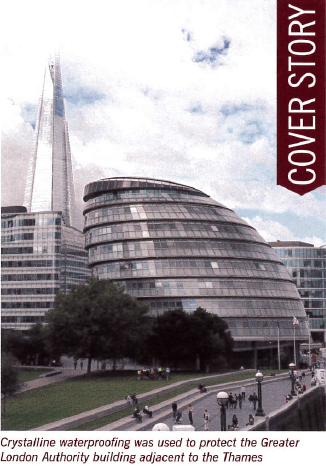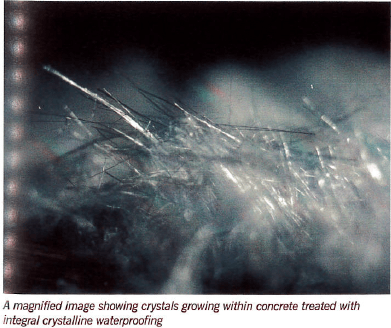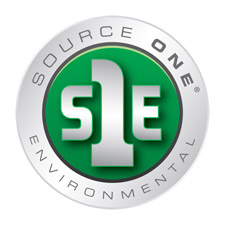The most used man-made material on the planet is concrete. All construction projects – small, medium, and large – have used concrete in one way or another.
However, as evidenced by crumbling infrastructure and structures the world over, the quality of the concrete can determine whether a project is truly viable or not. For example, building a bridge with a lifespan of 50 years is not economically viable when you consider the cost of initial construction, eventual repairs and the likelihood of early replacement.
Thus, the lifespan of a concrete structure is vital. With population growth and density of cities intensifying, constructing replacements of key infrastructure and buildings can be a costly and sometimes impossible process. Where it is possible, it creates a huge disruption to the local population. The longer these structures can last, the better.
 Concrete can deteriorate under a number of circumstances, including chloride attack/corrosion of steel reinforcement, sulphate attack, alkali aggregate reaction, and freeze/thaw cycles.
Concrete can deteriorate under a number of circumstances, including chloride attack/corrosion of steel reinforcement, sulphate attack, alkali aggregate reaction, and freeze/thaw cycles.
That being said, the most adverse influence on concrete durability involves the transport of fluids through the concrete. Water continues damage or destroys more buildings and structures than war or natural disasters. Of course, concrete does have water resistant capabilities, but it is at risk to water penetration. Thus, a waterproofing barrier is a must to lower the permeability and increase the durability of concrete.
To do so there are a few options in creating a concrete waterproof barrier, including crystalline admixtures; water repelling admixtures; densifying admixtures; densifying admixtures and water reducers; and surface applied membranes.
More times than not, the selection is narrowed down to the surface or external membrane and the internal membrane using crystalline technology.
The external membrane is a material that provides a barrier around the concrete structure in order to prevent the passage of water. Externally applied membranes are the traditional waterproofing method, but they have limitations that include tears, punctures, deterioration over time, and installation errors. If any of these occur, repair can be impossible because the membrane is not accessible through the concrete and it is hard to find the failed area that needs to be fixed. This ends in replacement which, if possible at all, involves a great deal of time and considerable expense.
An internal or integral waterproofing membrane is one that performs its function within the concrete as opposed to on the surface. This is the technology behind Permeability reducing Admixtures (PRA). The admixture becomes a permanent solution as it is part of the concrete mix. It lays dormant in the matrix until it comes in contact with moisture when it develops a needle-like microstructure to stop the flow of moisture.
 Furthermore, in North America the concrete waterproofing industry redefined their terminology a short time ago in a way which helps to clearly understand the differences between admixtures. In fact, the American Concrete Institute’s 212.3R-10 report on Chemical Admixture document devoted chapter 15 to Permeability Reducing Admixtures and outlines PRAH and PRAN classifications. Permeability Reducing Admixture – Hydrostatic Conditions, or PRAH products, are sufficiently able to resist water under hydrostatic pressure penetration and are suitable for watertight construction.
Furthermore, in North America the concrete waterproofing industry redefined their terminology a short time ago in a way which helps to clearly understand the differences between admixtures. In fact, the American Concrete Institute’s 212.3R-10 report on Chemical Admixture document devoted chapter 15 to Permeability Reducing Admixtures and outlines PRAH and PRAN classifications. Permeability Reducing Admixture – Hydrostatic Conditions, or PRAH products, are sufficiently able to resist water under hydrostatic pressure penetration and are suitable for watertight construction.
Conversely, damproofing admixtures are now referred to a Permeability Reducing Admixtures – Non-Hydrostatic Conditions reduce water absorption by repellent chemicals (soaps, oils) or partial pore blocking (densifiers). These admixtures are not suitable for concrete exposed under pressure and cannot protect in the presence of hydrostatic pressure. Waterproofing against hydrostatic pressure is an important distinction that sets PRAHs apart from PRANs.
Crystalline waterproofing is the durable concrete waterproofing solution worldwide. With sustainable building practices increasing in importance, and the lifespan of a structure intrinsically connected to this development, a reliable waterproofing solution that will last for the intended life of the concrete structures becomes paramount.
 For more information contact Source One Environmental on 01226397015, email contact @s1e.uk or visit the website www.s1e.co.uk. See also Micheal T. Kubal’s Construction Waterproofing Handbook.
For more information contact Source One Environmental on 01226397015, email contact @s1e.uk or visit the website www.s1e.co.uk. See also Micheal T. Kubal’s Construction Waterproofing Handbook.
Source: Construction National